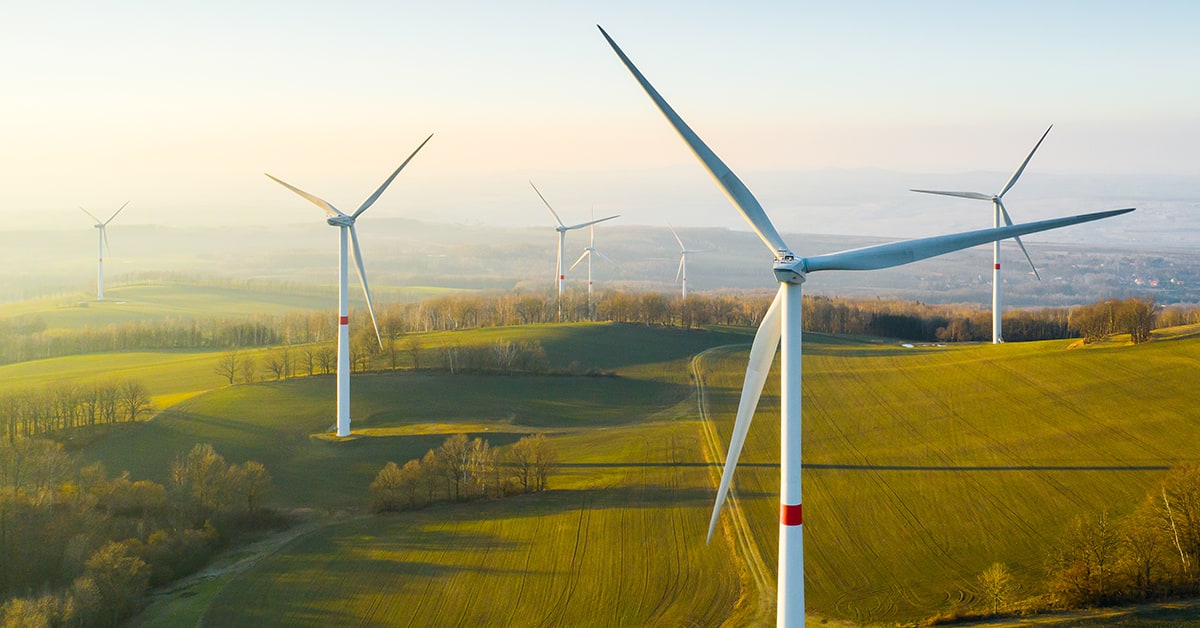Fossil fuels had a comeback year, but the green transition is accelerating.

Last year was the year the world remembered that it still needs fossil fuels. Global coal consumption passed a record set in 2013. China, the world’s coal giant, accelerated plans for new power plants burning that most-polluting fuel, and fudged targets for phasing out older ones.
Ministers from Germany’s Green Party trekked to Qatar to negotiate more imports of liquid natural gas (LNG). Brazil’s government slashed gasoline taxes that were intended partly to cut oil consumption. US President Joe Biden offered a price floor to stimulate more domestic crude production.
Does this revenge of the hydrocarbons mean slowing down the green transition everyone has been talking about for years? Actually, no. “Any headlines about going back to coal are purely short term,” says Will Riley, head of global energy strategy at Guinness Global Investors in London. “Events of the past year have accelerated the [green] transition.”
When it comes to renewable energy, governments, industry and the general public all took more steps forward than back in 2022. The US Congress passed the Inflation Reduction Act (IRA), which includes a package of green investments, tax credits and subsidies worth an estimated $369 billion over the next decade. “The IRA is a foundational strategy for helping us decarbonize transportation and power generation,” raves Mark Brownstein, head of energy transition at the Washington-based Environmental Defense Fund (EDF).
The European Commission (EC) targeted another €300 billion (about $324 billion) by 2030 toward new energy investment in its RePowerEU plan. While the bloc did scramble for LNG to replace Russian gas imports, most of this cash would be directed toward renewables and energy savings.
China may be adding coal power, but it’s adding green power much faster. Solar generating capacity jumped an estimated 20% in 2022, finds S&P, to approach 300 terawatts. “Recent ambitious announcements” flag Beijing’s determination to “develop solar [photovoltaic power] as a pillar of the new decarbonization strategy,” according to an S&P Global report.
Even Persian Gulf states are jumping on the bandwagon. Saudi Arabia, the United Arab Emirates and their neighbors are investing billions in solar generation, aiming to leapfrog to a leading role in the (perhaps) coming epoch of green hydrogen.
Industry is taking government green master plans seriously, particularly in China and Europe. Chinese output of polysilicon, the raw material for solar panels, is set to rise more than sevenfold from 2021-2024, according to Beijing-based consultant Asia Europe Clean Energy (Solar) Advisory. Solar module production may have nearly doubled already in the past year.
Wind power, which lately has been sleepy compared to solar, is leaping forward in Europe thanks to offshore projects in the blustery North Sea. In November, Norwegian oil and gas producer Equinor drew its first power from its Hywind Tampen facility, slated to be the world’s largest floating wind farm, with a 60 megawatt capacity.
The IRA is a foundational strategy for helping us decarbonize transportation and power generation.
—Mark Brownstein, EDF
That would outgenerate the Kincardine floating wind farm, with 50 megawatts, which launched in 2021 off the North Sea coast of Scotland. UK auctions last summer drew pledges to add 7 gigawatts more offshore wind by 2026, at steadily decreasing prices. “With its world-class wind resources, the North Sea will continue to play a key role in the energy transition and for the energy security of Europe,” Equinor boasted in its November announcement.
Consumers are also accelerating the green transition from the bottom up. Europe is the epicenter here, as households flock to get off natural gas, the price of which has doubled on the continent over the past year. Rooftop solar collectors are one alternative. Heat pumps that run on electricity and replace gas furnaces are another. Growth projections for both within the EU jumped by a third last year, says Nikolai Dobrott, managing partner of Berlin-based consultant Apricum. “Residential owners are scared of gas prices,” he says. “All the solar installers are sold out for months ahead.”
Asian consumers, unburdened by European heating bills, are pushing the green tide by switching to electric vehicles (EV). EV sales jumped by a third last year in Southeast Asia, with Thailand leading the way. An EV manufacturing revolution is also brewing within the Asean countries and India. Production has surged from near zero in 2020 and will reach two million four-wheeled units a year by 2030, McKinsey & Co. predicts.
Changing Momentum
Still, renewable energy has lost some economic momentum in recent years. The price of solar generation, which dropped by more than 50% from 2013-2020, has leveled out since then, S&P reports. EV battery prices rose 7% last year on materials costs, reports Bloomberg, the first increase in the 12 years that Bloomberg has tracked them.
Volatile fossil fuel prices also strengthened the case for renewables anyway. The cost of crude oil climbed by more than 50% in the first half of 2022, according to Trading Economics, before ending the year about where it started. Coal prices jumped 100% or more in Asia and elsewhere. The cost competitiveness of renewables is well established. “Renewables are already the cheapest source of new power generation in most markets across the world,” S&P observes.
The prime catalyst last year was politics, though, as Russian President Vladimir Putin blew up Russia’s 50-year history of supplying gas to Europe and the Biden administration wrestled its huge green deal through Congress.

Putin’s response to EU sanctions reminded the whole world of the perils of depending on imported energy, Guinness’ Riley notes, and that elevated green power from a long-term goal based on climate projections to a shorter-term national security imperative. “The obvious way out of overdependence on imported hydrocarbons is localized, distributed renewables,” he comments.
The havoc wrought by climate change, meanwhile, becomes less abstract with every fresh not-quite-natural disaster: from a Rhine River too low for shipping, to East African drought, to biblical deluges in Pakistan and California and fires in the Siberian Arctic. “The litany of climate catastrophes has been visited on virtually every region of the world,” the EDF’s Brownstein says.
Politics and technology are combining to push development of hydrogen fuels, the hoped-for over-the-horizon next step in the green revolution. Hydrogen molecules are broken off from water by a process called electrolysis. They can be a portable carbon-free fuel for uses an electrical grid doesn’t reach, such as ships and airplanes—or for which it lacks enough juice, such as steelmaking. Hydrogen fuel cells have been a bust for cars, but they might still power trucks and buses of the future using less metal than lithium-based batteries.
Hydrogen Hopes
The holy grail for the environment is “green” hydrogen, for which the electrolysis is powered by renewable resources with low carbon emissions. S&P already saw a “tipping point” for this wonder fuel in 2022, with investments in electrolysis more than doubling worldwide. And that was before the US IRA, which offers to subsidize about half the current cost of producing green hydrogen, up to $3 per kilogram in absolute terms. “If there’s such a thing as a game changer, that IRA tax credit is it,” enthuses Stephen Crolius, president of Carbon Neutral Consulting in Warwick, Rhode Island.
Green hydrogen produced in the Persian Gulf faces no small challenge reaching export markets: The gas has to be chilled to -253 degrees Celsius (-423 degrees Fahrenheit) to liquefy it for shipment—a costly process that burns up almost a third of hydrogen’s energy, according to the US Department of Energy. State oil firms are funding projects anyway.
Last year saw signs of resurrection for an early green technology that had been largely left for dead: carbon capture and storage. The idea of sucking planet-warming carbon dioxide (CO2) out of the air sounds good, but it bogged down on obstacles like requiring more energy than it was worth, and lack of suitable underground “storage space.”
Investors started taking another look in 2022. Swiss firm Climeworks bagged 600 million Swiss francs (about $660 million) in private equity funding for a plant pumping captured CO2 into rock formations deep underground in Iceland. Across the world in Texas, Occidental Petroleum announced it would spend up to $1 billion on “direct air capture” of CO2 emissions from the Permian shale oil basin, the largest US oil patch. Profit it earns from selling carbon credits to customers like aviation giant Airbus could in time surpass earnings from the company’s chemicals division, CEO Vicki Hollub predicted.
Petroleum giant Exxon Mobil promises it too is “advancing plans for multiple new carbon capture and storage opportunities around the world,” without being too specific. The US Inflation Reduction Act should help here, too, more than tripling the tax credit for direct air carbon capture to $180 per metric ton (1.1 US tons) if it is then sequestered, or to $130 per metric ton if it is captured and used.
Brownstein and the EDF are working with the oil industry on what he sees as lower-hanging fruit: reducing the amount of natural gas that is “flared” during drilling. This waste reduces fuel supplies and spews methane, a super greenhouse gas, into the atmosphere.
About 5% of global gas production, 210 billion cubic meters (about 7.4 trillion cubic feet) a year, is burnt off uselessly at the wellhead, according to the US Energy Information Agency. That could be slashed by 45 billion cubic meters over the next three years with readily available technology. “Both industry and government have become too complacent about these methane losses,” Brownstein says. “It’s the first place importers like Europe, Japan and Korea are looking to increase supply.”
New frontiers for the green transition do involve new problems. Redefining renewable energy as a national security issue may inspire nations to go greener faster. It also collides with the inconvenient truth that China dominates the renewables supply chain, far more than any single exporter controls hydrocarbons. China produces over 70% of the world’s photovoltaic modules; the US and Europe combined, 5%. China processes 60% of the rare earth metals essential to solar and wind power and to EVs; the US, 15%.
The US IRA aims to close this yawning gap, even as it turbocharges the top economy’s green rollout. Its generous subsidies and investments are largely reserved for domestic production. “A lot of the IRA measures are America first,” notes Hunter Kornfeind, an analyst at Washington-based Rapidan Energy Group.
That’s raised hackles even among US allies like South Korea and the EU. EC President Ursula von der Leyen urged “rebalancing” initiatives to counter the “distortions” in the US legislation. Biden told visiting French President Emmanuel Macron that “there are tweaks that we can make.”
But Europe is eyeing similar protectionism to restore its lost primacy in green technologies. “The hot topic is localizing production in Europe,” Apricum’s Dobrott says. “In 2008, Germany was the global leader in both [photovoltaic power] and wind turbines.”
The long-term goal of breaking dependence on China will lead to short-term slowdowns in the green transition elsewhere. US solar installations dropped by a quarter last year, according to a report by energy consultant Wood Mackenzie and the Solar Energy Industries Association (SEIA). The main drag was a new ban on importing components that contain polysilicon from the Xinjiang region, where Beijing is accused of herding ethnic Uyghurs into concentration camps. “America’s clean energy economy is being hindered by its own trade actions,” complained Abigail Hopper, president of the SEIA, in a December statement.
THE BIG CHALLENGES AHEAD
Among a legion of technical challenges, two stand out. The first is extracting all the metals needed for the expected explosion of EVs and renewable power transmission. Global demand for copper will double by 2035, with supply lagging by 20%, S&P Global projects. Mining companies, burnt by past boom-bust cycles and confronting a new left-leaning government in the most copper-rich country, Chile, are not rushing to fill that gap.
The second big challenge, scientifically more complex, is developing storage systems that can capture solar and wind energy when the sun shines and the wind blows, then release it to consumers when they don’t. Renewable power generation has made great leaps forward over the past decade to reach price parity with coal and natural gas. Storage remains in the experimental stage.
One focus is a “two-way flow of power” connecting standalone solar installations and EV batteries to feed excess energy into the utility grid—“a universe of virtual power plants,” as Will Riley describes it. Yet for this grids need to be redesigned at enormous cost. “Broadly speaking, you’re seeing significant delays in that process,” Riley notes.
Scientists and startups are kicking around a range of methodologies for larger-scale and longer-duration storage. One is “flow batteries,” which are shipping-container-sized tanks filled with different chemicals that exchange ions back and forth. Subsurface waterways are also under investigation. So are underground salt deposits, which could be heated above 500 degrees Celsius then release that energy gradually.
None is expected to deploy anytime soon. “Connecting groundbreaking projects in time to boost storage adoption by 2030 seems increasingly unlikely,” says Carrie Bellamy, director of commercialization at Malta, an energy storage innovator in Cambridge, Massachusetts.
The biggest challenge of all will be making up for lost time in the climate change fight. Scientists flagged the greenhouse effect as a cause for “real concern” in the 1960s. Concerted global efforts to do something about it only gelled five decades later, with the 2015 Paris Agreement. “I’m very optimistic that we will get the energy transition done over the next 30 years,” Carbon Neutral’s Crolius says. “I’m very pessimistic as to whether this will prevent us from experiencing devastating effects of climate change.”
Still, moving forward is better than sliding back.



